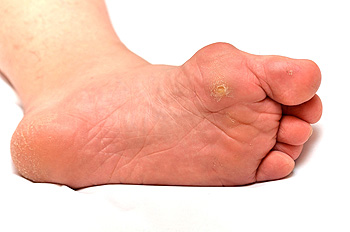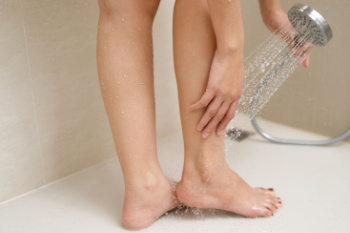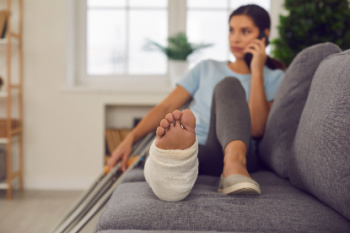Connect With Us
Blog
Items filtered by date: January 2025
Managing Corns on the Feet

Corns are thickened areas of skin that develop on the feet due to repeated friction or pressure. They typically form on the toes or the soles of the feet and can cause discomfort or pain, especially when standing or walking. Symptoms include a small, hard, raised bump that may appear yellowish or gray, with surrounding redness and inflammation. The primary cause of corns is wearing tight or ill-fitting shoes that put pressure on specific areas of the foot. Abnormal gait or foot deformities, such as hammertoes, can also contribute to corn formation. Treatment options for corns often include soaking the feet to soften the skin, and wearing properly fitting shoes with adequate cushioning. In severe cases, a podiatrist may recommend professional corn removal, along with custom orthotics to prevent recurrence. If you have developed one or more corns on your feet, it is suggested that you schedule an appointment with a podiatrist.
If you have any concerns regarding your feet and ankles, contact one of our podiatrists of Save Your Soles. our doctors will treat your foot and ankle needs.
Corns: What Are They? and How Do You Get Rid of Them?
Corns can be described as areas of the skin that have thickened to the point of becoming painful or irritating. They are often layers and layers of the skin that have become dry and rough, and are normally smaller than calluses.
Ways to Prevent Corns
There are many ways to get rid of painful corns such as wearing:
- Well-fitting socks
- Comfortable shoes that are not tight around your foot
- Shoes that offer support
Treating Corns
Treatment of corns involves removing the dead skin that has built up in the specific area of the foot. Consult with our doctors to determine the best treatment option for your case of corns.
If you have any questions please feel free to contact our offices located in Abington and Willow Grove, PA . We offer the newest diagnostic and treatment technologies for all your foot and ankle needs.
Loving Your Feet

Your feet carry you through life, so give them the care they deserve to keep them looking and feeling their best. Start by washing the feet daily with warm water and mild soap and dry them thoroughly, especially between the toes. Keep your nails trimmed straight across to prevent ingrown toenails, and use a moisturizer to help prevent dryness and cracking. Wear properly fitted shoes that support your arches and cushion your soles to reduce strain and discomfort. Pamper your feet with regular massages or soak them in warm water with Epsom salts. Stay active to promote healthy circulation and do not ignore any pain, swelling, or unusual changes. Small acts of foot care can make a big difference in your feet’s health and appearance. If you have any foot or ankle concerns, it is suggested that you seek expert advice and treatment from a podiatrist for a professional assessment and personalized care plan.
Everyday foot care is very important to prevent infection and other foot ailments. If you need your feet checked, contact one of our podiatrists from Save Your Soles. our doctors can provide the care you need to keep you pain-free and on your feet.
Everyday Foot Care
Often, people take care of their bodies, face and hair more so than they do for their feet. But the feet are a very important aspect of our bodies, and one that we should pay more attention to. Without our feet, we would not be able to perform most daily tasks.
It is best to check your feet regularly to make sure there are no new bruises or cuts that you may not have noticed before. For dry feet, moisturizer can easily be a remedy and can be applied as often as necessary to the affected areas. Wearing shoes that fit well can also help you maintain good foot health, as well as making it easier to walk and do daily activities without the stress or pain of ill-fitting shoes, high heels, or even flip flops. Wearing clean socks with closed shoes is important to ensure that sweat and bacteria do not accumulate within the shoe. Clean socks help to prevent Athlete’s foot, fungi problems, bad odors, and can absorb sweat.
If you have any questions please feel free to contact our offices located in Abington and Willow Grove, PA . We offer the newest diagnostic and treatment technologies for all your foot and ankle needs.
Is My Ankle Broken?

A broken ankle can cause immediate and severe pain, along with visible bruising, swelling, and sometimes joint deformity. In some cases, the ankle may appear misshapen or out of alignment, and you may be unable to bear weight on the injured foot. The most common causes of a broken ankle include falls, sports injuries, or accidents that involve twisting or rolling the ankle. Treatment for a broken ankle typically includes elevation along with immobilization, using a cast or brace. If the fracture is more severe or displaced, surgery may be needed to realign the bones and secure them with pins, plates, or screws. Proper diagnosis and treatment are key to ensure the ankle heals correctly and to prevent long-term complications like instability or arthritis. Visiting a podiatrist can help you get the right care. If you suspect you have broken your ankle, it is suggested that you make an emergency appointment with a podiatrist.
Broken ankles need immediate treatment. If you are seeking treatment, contact one of our podiatrists from Save Your Soles. our doctors can provide the care you need to keep you pain-free and on your feet.
Broken Ankles
A broken ankle is experienced when a person fractures their tibia or fibula in the lower leg and ankle area. Both of these bones are attached at the bottom of the leg and combine to form what we know to be our ankle.
When a physician is referring to a break of the ankle, he or she is usually referring to a break in the area where the tibia and fibula are joined to create our ankle joint. Ankles are more prone to fractures because the ankle is an area that suffers a lot of pressure and stress. There are some obvious signs when a person experiences a fractured ankle, and the following symptoms may be present.
Symptoms of a Fractured Ankle
- Excessive pain when the area is touched or when any pressure is placed on the ankle
- Swelling around the area
- Bruising of the area
- Area appears to be deformed
If you suspect an ankle fracture, it is recommended to seek treatment as soon as possible. The sooner you have your podiatrist diagnose the fracture, the quicker you’ll be on the way towards recovery.
If you have any questions, please feel free to contact our offices located in Abington and Willow Grove, PA . We offer the newest diagnostic and treatment technologies for all your foot care needs.
Let the Expert Treat Your Ingrown Toenails
Choosing Running Shoes for Your Terrain and Running Style

Selecting the right running shoe is essential for comfort, performance, and injury prevention. One of the first considerations is the terrain you plan to run on. For road runners, shoes with a cushioned, flexible sole are ideal to absorb the impact on hard surfaces. If you prefer trail running, shoes with deeper treads and a more rugged sole offer better traction on uneven and slippery surfaces. Additionally, your running style is important. If you tend to pronate, meaning your feet roll inward, shoes with added arch support will help maintain proper alignment. Those with a neutral stride may benefit from shoes with balanced cushioning. Ensure the shoes provide adequate room in the toe box and a snug fit around the heel to prevent discomfort. Wearing shoes that do not fit correctly may lead to pain and discomfort. If you need help selecting the right running shoe, it is suggested that you consult a podiatrist who can help you choose the correct pair.
You should always make sure your running shoes fit properly in order to avoid injury. For more information, contact one of our podiatrists from Save Your Soles. our doctors can provide the care you need to keep you pain-free and on your feet.
Choosing the Right Running Shoe for Your Foot Type
Improper shoe sizing can cause a myriad of problems for your feet. Shoes that don’t fit you properly can lead to muscular imbalances in your body, which can result in foot, knee, and hip injuries.
Tips for Finding the Right Running Shoe
- Make sure you have a thumb’s width of wiggle room between the end of your longest toe and the front of the shoe.
- There should be little to no slipping at the heel
- Don’t assume your size in one shoe brand will be your size in another
- Do not lace up your shoes too tightly
- Walk around in the store with your new shoes before you buy them
If you have any questions please feel free to contact our our offices located in Abington and Willow Grove, PA . We offer the newest diagnostic and treatment technologies for all your foot and ankle needs.

